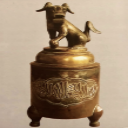A (rather) minimalist look
Our incense burner is essentially devoid of ornaments, except for the inscriptions around its body. This lack of figural patterns distinguishes it from the ancient bronze ritual vessels it originated in. Archaic bronze vessels are often embellished with intricate patterns of clouds, floral and animal forms. An example is a spectacular bronze vessel, gui in the British Museum, made about 3000 years ago, with elaborate flower-like decorations on bands at the top and bottom, but its most striking features are its handles, each of which is a large beast with tusks, horns and huge square ears caught in the act of swallowing a bird whose beak is just emerging from its jaws.
Figural ornaments are generally eschewed in the art and architecture of the Islamic world. The opposition to figuration is based on traditions of the Prophet Muhammad, the Hadith. The two principal objections to figuration in prescriptive texts are that it is prohibited to usurp divine creative powers, and a fear of polytheism and idolatry.
By contrast, anthropomorphic and zoomorphic images proliferated in secular arts. A surviving example is a twelfth-century lion-shaped bronze censer made in Iran. The head is removable so that coal and incense could be placed inside, and the body and neck are pierced so that the scented smoke could escape. The Arabic inscriptions around the feline’s neck and chest are from the Qur’an sura al-jum’ah (The Friday Congregation) reminding worshippers to set work aside, attend prayer, and then disperse to seek God’s bounty. This monumental feline certainly would have been used in a domestic, secular (possibly palatial) setting, as its zoomorphic attributes would have made it unsuitable for public, religious settings such as a mosque.
The Chinese Muslims recognized the importance of non-figural decoration within a religious context. Incense burners used in places of worship are typically plain or with simple calligraphic inscriptions. However, outside the boundaries of religious texts, they also incorporate a wide variety of decorative motifs popular in traditional Chinese art, drawn from sources rooted in legendary, philosophical, historical and religious traditions of Buddhist, Taoist and Confucian streams.
To summarize the aniconic doctrine in Islamic art in simple terms: a certain degree of flexibility distinguishes the public arts, in general free of images, and the private arts, which enjoy greater freedom of expression and taste.
](https://micrio.thingsthattalk.net/VzxMo/views/max/205x128.png)
](https://micrio.thingsthattalk.net/mdaIY/views/max/128x128.s.jpg)
